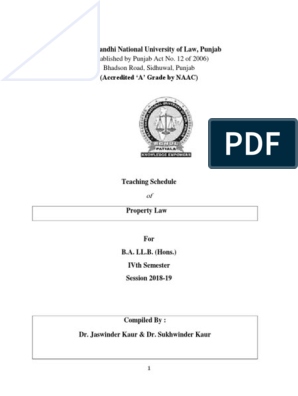historical evolution of the Transfer of Property Act, 1882
Introduction:
The Transfer of Property Act, 1882 is a central piece of legislation that governs the transfer of
property between living persons (inter vivos) in India. Prior to its enactment, the law relating to
property transfers was scattered across customs, religious texts, English common law, and various
judicial interpretations. The enactment of this statute marked a significant step toward codification
and unification of property law in colonial India.
Background and Need for the Act:
Before 1882, there was no comprehensive statute governing property transfers in British India.
Courts relied heavily on:
● Hindu and Muslim personal laws for succession and inheritance,
● English law of equity and common law principles, applied inconsistently,
● Customary practices, which varied regionally.
This resulted in uncertainty, inconsistency, and confusion in adjudication. A need was felt to frame
a uniform and codified law applicable to all communities (except where personal laws prevailed) in
matters of property transfer between living persons.
Drafting and Enactment:
● The process began under the guidance of the First Law Commission (1834), chaired by Lord
Macaulay, but property law was not addressed immediately.
● The real effort began in the 1870s, under the direction of Sir Arthur Hobhouse, a member of
the Council of India.
● The first draft of the Bill was introduced in 1877, but it was heavily criticized by judges and
lawyers for being too abstract and technical.
● A revised version of the Bill, incorporating practical suggestions, was introduced in 1881
and finally enacted on 17 February 1882 as the Transfer of Property Act, 1882, which came
into force on 1 July 1882.
�Scope and Application:
The Act originally contained 8 chapters and 137 sections, but over time, several chapters (e.g.,
Chapter V on leases) were repealed or merged into other laws. Today, the Act focuses on:
● General principles of transfer (Sections 5 to 37),
● Specific types of transfer such as sale, mortgage, lease, exchange, and gift (Sections 38
onwards).
The Act applies only to transfers between living persons and does not govern testamentary transfers
(which are dealt with under the Indian Succession Act, 1925).
Major Amendments and Judicial Development:
● Amendment Acts of 1929, 2002, and others refined several provisions relating to gifts,
leases, and mortgages.
● Important judicial interpretations have shaped the understanding of concepts like “transfer”,
“property”, “interest”, and “notice”.
● The courts have also harmonized the Act with personal laws where necessary, especially in
matters of succession and inheritance.
Significance in the Indian Legal Framework:
The Transfer of Property Act, 1882 was a pioneering codification of Indian property law:
● It codified equitable principles derived from English law but adapted them to Indian
conditions.
● It played a crucial role in legal certainty and ease of property transactions.
● It became a supplement to personal laws by governing inter vivos transfers while allowing
religious customs to govern other areas like succession.
Conclusion:
The Transfer of Property Act, 1882 represents a landmark in the history of Indian legal
development. Its enactment filled a critical gap in the colonial legal system and laid down clear,
uniform principles for the transfer of immovable property. While the Act has undergone significant
�judicial and legislative refinement, its foundational structure remains intact, continuing to guide
property transactions across India with clarity and legal authority.


























































































